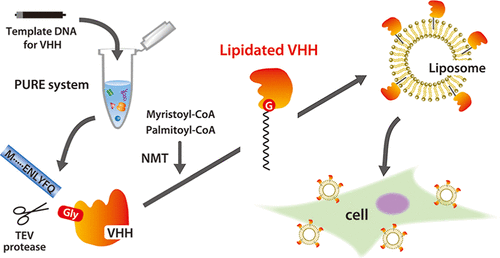A paper on post-translational lipid modification and membrane localization of proteins using PUREfrex® has been published
A paper on post-translational lipid modification and membrane localization of proteins using PUREfrex® by joint research by Gene Frontier, Tokyo Institute of Science and Japan Agency for Marine-Earth Science and Technology (JAMSTEC) has been published in ACS Synthetic Biology.

In this paper, we developed a cell-free system for the myristoylation and palmitoylation of nascent proteins using the PURE system (Product name: PUREfrex®).
Post-translational modifications are an essential process for proper protein function and localization. In particular, lipid modification plays a crucial role in the spatial regulation of proteins functioning on a lipid membrane surface. While cell-free protein synthesis allows rapid protein production, technical advances in lipidation modification are behind.
Based on our previous study, we improved myristoylation efficiency by trimming a precursor nascent peptide, which undergoes lipidation at the N-terminal glycine. We also found that N-myristoyltransferase (NMT) catalyzes both myristoylation and palmitoylation. The localization of lipidated proteins onto liposomes is further aided by the insertion of polyarginine residues downstream of the NMT recognition site. Finally, we demonstrated that lipidation of VHH antibodies and localization onto liposomes resulted in target-specific binding to cancer cells.
This system offers a platform for displaying soluble proteins on lipid membranes, with potential applications in developing liposomes for targeted cell binding.
Lipid Modification and Membrane Localization of Proteins in Cell-Free System
ACS Synthetic Biology (2025), in press.
Download paper: https://pubs.acs.org/doi/10.1021/acssynbio.5c00155
